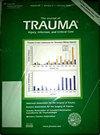The incidence of chronic pain following tibial diaphyseal fracture.
Journal of Trauma-Injury Infection and Critical Care
Pub Date : 2019-01-01
DOI:10.35841/2591-7358.3.1.6-11
引用次数: 1
Abstract
Introduction: Chronic pain affects up to 40% of patients at 7 years after tibial fracture impacting on their quality of life (QoL) and ability to participate in activities of daily living. Major nerves run in close proximity to the tibia and are prone to injury during tibial fracture. Nerve injury can cause acute neuropathic pain, which responds poorly to commonly prescribed analgesics and predisposes patients to developing chronic pain. This study aims to describe the incidence and impact of pain at 6-12 months after tibial fractures. Methods: Patients admitted to a major trauma centre between 01/01/2016 – 31/12/2016 with isolated tibial fractures were identified using prospectively recorded database eTrauma. Injuries were categorized using the AO classification. Pain and Quality of Life at 6-12 months post injury were assessed using the EuroQol (EQ-5D-5L) questionnaire and the Douleur Neuropathique 4 questionnaire for neuropathic pain. Results: Forty isolated tibial fractures were identified and 20 were followed up. Pain was reported by 18 (90%) of patients. Ten (50%) reported moderate to severe pain, with median pain scores of 2.6/5. Pain scores were significantly greater following high-energy injuries however no significant links were seen between pain and other patient, injury or management factors. Conclusion: Chronic pain is common following tibial fracture and is largely under-reported. Further prospective multi-center investigation is warranted to better identify those with neuropathic pain and other risk factors for chronic pain. This could guide effective management and improve patient outcomes胫骨骨干骨折后慢性疼痛的发生率。
在胫骨骨折后7年,慢性疼痛影响高达40%的患者,影响他们的生活质量(QoL)和参与日常生活活动的能力。主要神经靠近胫骨,在胫骨骨折时容易受到损伤。神经损伤可引起急性神经性疼痛,这种疼痛对常用的镇痛药物反应不佳,容易使患者发展为慢性疼痛。本研究旨在描述胫骨骨折后6-12个月疼痛的发生率和影响。方法:使用前瞻性记录数据库eTrauma对2016年1月1日至2016年12月31日在一家大型创伤中心收治的孤立性胫骨骨折患者进行识别。采用AO分类对损伤进行分类。采用EuroQol (EQ-5D-5L)问卷和Douleur神经性疼痛4问卷对损伤后6-12个月的疼痛和生活质量进行评估。结果:发现孤立性胫骨骨折40例,随访20例。18例(90%)患者报告疼痛。10例(50%)报告中度至重度疼痛,中位疼痛评分为2.6/5。高能量损伤后的疼痛评分明显更高,但疼痛与其他患者、损伤或管理因素之间没有明显联系。结论:胫骨骨折后慢性疼痛是常见的,但在很大程度上被低估了。进一步的前瞻性多中心研究是必要的,以更好地识别神经性疼痛和其他慢性疼痛的危险因素。这可以指导有效的管理并改善患者的预后
本文章由计算机程序翻译,如有差异,请以英文原文为准。
求助全文
约1分钟内获得全文
求助全文
来源期刊

Journal of Trauma-Injury Infection and Critical Care
CRITICAL CARE MEDICINE-EMERGENCY MEDICINE
自引率
0.00%
发文量
0
审稿时长
3 months
 求助内容:
求助内容: 应助结果提醒方式:
应助结果提醒方式:


